#sikh warrior
Text
there is something to be said about the way colonial labels will be absorbed by colonized peoples. particularly i think about the way the british labeled sikhs as a martial race and that continues to this day amongst sikhs.
#i am personally disdainful towards the reclamation of these things#id rather the complete abandonment of these ideas#of course it's more complex than that#because historically sikhs have been involved in many military conflicts and many of our important cultural figures are warriors#but there is a difference with that and accepting the moniker of 'martial race'
7 notes
·
View notes
Text
DHAN BABA DEEP SINGH JI
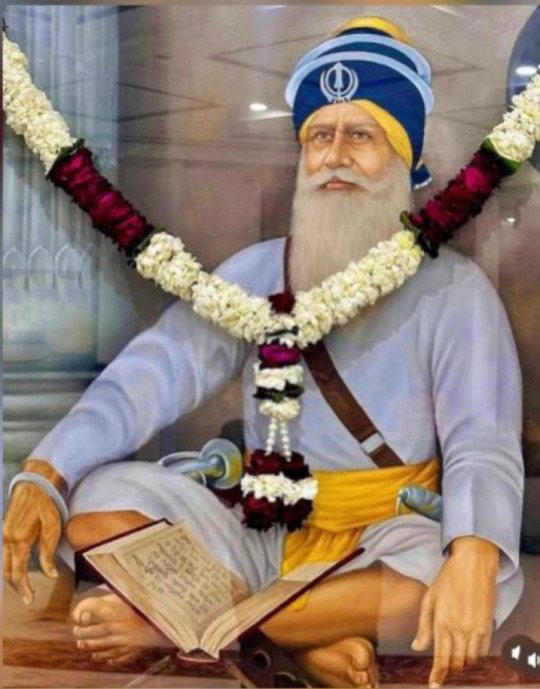
BABA DEEP SINGH JI SHAHEED 🙏🏻 (26 January 1682 - 13 November 1757)
“ਜਉ ਤਉ ਪ੍ਰੇਮ ਖੇਲਣ ਕਾ ਚਾਉ॥ ਸਿਰੁ ਧਰਿ ਤਲਿ ਗਲੀ ਮੇਰੀ ਆਉ॥ ਇਤੁ ਮਾਰਗਿ ਪੈਰੁ ਧਰਿਜੇ ॥ ਸਿਰੁ ਦਿਜੈ ਕਾਣਿ ਵ ਕੀਜੈ ॥੨੦ ॥”
( If you desire to play this game of love with Me (god), Then stop onto My Path with your head in Hand. When you place your feet on this Path, Give me your head and don’t pay any attention to public opinion. ॥20॥)
{From: Guru Granth Sahib Ji, Ang: 1410 to 1412, section: Salok Varan Thay Vadhekh }
Baba Deep Singh ji was a Sikh leader known for his bravery and devotion to Sikhism also one of the most hollowed martyrs in Sikhism. He is remembered for his sacrifice and devotion to the teachings of the Gurus .
Baba Deep Singh ji was born on 26 January 1682 in Sandhu Jatt Sikh family. His father name was “Bhai Bhagta ji” and he was a farmer and his mother was “Mata Jioni Ji”. He born in Pahuwind village in Tarn Taran, Amritsar district of Punjab, India.
He was the first head of Misl Shaheedan Tarna Dal and first head of Damdaki Taksal, then head of Sharomani Panth Akali Buddha Dal.
The Battle of Amritsar, also known as the “Siege of Amritsar”, occurred in 1757. It was a fierce battle between the Sikhs and the Mughal forces. The Sikhs were defending the city Amritsar and the Golden Temple from the Mughals Afghan Army. During the battle, Baba Deep Singh offered prayers before starting “May My Head Fall At The DARBAR SAHIB”. Baba Deep Singh, who was in his 70s, displayed exceptional courage and determination. Despite being severely wounded, he continued fighting and ultimately fulfilled his vow to reach the Golden Temple. His act of bravery and sacrifice is celebrated in Sikh history and culture.
In 1757 on 13 November, during the Battle of Amritsar, he fought fearlessly and sacrificed himself . The Battle of Amritsar strengthened the resolve of the Sikh community and solidified their commitment to defending their faith and sacred sites. It also contributed to the historical significance of the Golden Temple in Sikhism.
He also fought the Battle of Chapal Chiri (1710), Battle of Sadhuara (1710) and Siege of Sirhind (1710) alongside with BaBa Banda Singh Bahadur.
His courage, dedication and legacy is a powerful reminder of the strength of faith and the importance of standing up for what you believe and also for religion. Baba Deep Singh Ji's unwavering determination and fearlessness in the face of adversity are truly inspiring. His commitment to protecting the Golden Temple and his willingness to sacrifice himself for his beliefs are qualities that inspires us to be stand up for ourselves.
#sikhism#sikh#khalsa#babadeepsinghji#amritsar#punjab#punjabi#history#martyrs#writers on tumblr#religion#january#trendingtopics#writing community#lu warriors
8 notes
·
View notes
Photo

Sikh Sarbloh Kara Smooth Design Singh Kaur Khalsa Kada Bangle Kakaar 5Ks New DD3 Sikh Sarbloh CHAKRI Kara Smooth Design Singh Kaur Khalsa Kada Bangle Kakaar 5Ks New. Kara Ref: DD3 Width is approx 8.3mm Thickness from inner side of Chakri to the edge of Chakri is approx. 12.3mm Weight Approx 110-155g (Variable due to size) Handmade design - therefore each kara is a Unique design Please note these Pure Sarbloh Kara are very hard to find and is a customised design exclusive to OnlineKaraStore These karas are from the Holy City of Amritsar (Golden Temple/Darbar Sahib). KARA Size is the internal diameter of Karas measured in CMs. There may be little bit rust present which is seen commonly in all SARBLOH KARAS due to purity of the metal/wrought iron. Cuts, dings and scruff Mark's may present as these kara are hand made and transported in Jumble in Jute bags. However, our kara will be near to perfection as we get these manufactured on demand and use bubble wraps to transport these. Please read below more Information about Sikh Kara: A kara (Punjabi: ਕੜਾ (Gurmukhi), کڑا (Shahmukhi) कड़ा (Devanagari)), is a steel or iron (sarb loh) bracelet, worn by all initiated Sikhs. It is one of the five kakars or 5Ks — external articles of faith — that identify a Sikh as dedicated to their religious order. The kara was instituted by the tenth Sikh guru Gobind Singh at the Baisakhi Amrit Sanskar in 1699. Guru Gobind Singh Ji explained: He does not recognise anyone else except me, not even the bestowal of charities, performance of merciful acts, austerities and restraint on pilgrim-stations; the perfect light of the Lord illuminates his heart, then consider him as the immaculate Khalsa. The kara is to constantly remind the Sikh disciple to do God's work, a constant reminder of the Sikh's mission on this earth and that he or she must carry out righteous and true deeds and actions, keeping with the advice given by the Guru. The Kara is a symbol of unbreakable attachment and commitment to God. It is in the shape of a circle which has no beginning and no end, like the eternal nature of God. It is also a symbol of the Sikh brotherhood. As the Sikhs' holy text the Guru Granth Sahib says "In the tenth month, you were made into a human being, O my merchant friend, and you were given your allotted time to perform good deeds." Similarly, Bhagat Kabir reminds the Sikh to always keep one's consciousness with God: "With your hands and feet, do all your work, but let your consciousness remain with the Immaculate Lord." The basic kara is a simple unadorned steel bracelet, but other forms exist. It was historically used like a knuckle-dusterfor hand-to-hand combat. Battlefield variations include kara with spikes or sharp edges. Sikh soldiers of the British Indian army would settle disputes by competing in a form of boxing known as loh-musti (lit. iron fist) with a kara on one hand. PLEASE NOTE: Please measure/check size of your kara/bracelet first while ordering to avoid any hassle or posting it back to us and paying extra for p&p for exchange and swap of karas with other desired sizes. There will be charge of £5 p&p towards exchange/swap of Kara for any size issues for UK buyers and £12 p&p for international buyers that needs to be paid by PayPal in advance or interested buyer can send us pa repaid self addressed envelope for any exchange/swap along with the original item in its original packaging and buyer should also return us the gift item/bags sent along with the item for appreciation of purchase. We may post back gift items/bags along with the swapped item. P.S. Colour of item may slightly vary due to camera flash and light conditions. Some Karas may have negligible small black grinding mark on the kara joint. This is always seen on all karas as most of the Kara making/shaping work is done by hands. However, this do not affect the quality/look of Kara. #Kara #KaraforLife #SikhKara #SarblohKara #Sarbloh #5Ks #SinghKara #SikhBracelet #KhalsaKada #Kada #SinghisKing Brilliant finish and very decorative. Ideal gift item for loved ones on any Occasion. Please follow us on Facebook, Instagram and Twitter @OnlineSikhStore #OnlineSikhStore Free Royal Mail Postage in UK. Postage discounts will be given to International buyers for multi-buys. Any questions please do not hesitate to contact us. P.S. Colour of item may slightly vary due to camera flash and light conditions. Size is approximate it and may differ by few mm from Kara to Kara or because of Digital Vernier Calliper errors. There may be rust present or marks of rust present as rust is natural characteristic of pure iron/sarbloh. These kara do require cleaning with Sharp Sand or Brasso Polish. These are usually treated with coconut oil to maintain shine after cleaning.
#round chakri kada#Sarbloh bangle#sikh sikhi sikhism#punjabi steel bangle#panjabi karra kaday#singh kaur khalsa#pure iron loha kada#stainless steel kara#silver bangle#gatka martial arts#smooth chakri chakra#warrior odha yudh#brave soldier saint
3 notes
·
View notes
Text
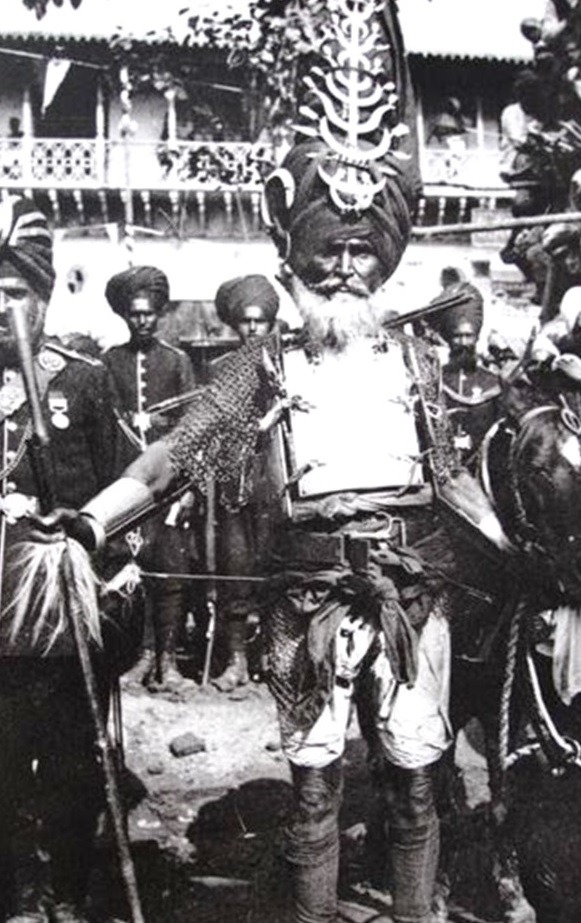
A battle-hardened Nihang Singh (traditional Sikh warrior) with a dastaar bunga (tower turban) adorning a gajga (a martial iron ornament) and traditional body armour. He seems in better shape than the younger and modern Sikh soldiers surrounding him
#Sikh#warrior#nihang#akali#vintage#britishraj#sikhempire#turban#weapons#shastars#armour#armor#shastar vidya#gatka#martial#martial arts
4 notes
·
View notes
Text
The history of the Sikh is a rich palette of spiritual evolution, brave warriors and unshakable principles that have left an indelible mark on the world. The roots of Sikhism date back to the 15th century in the South Asian state of Punjab, where Guru Nanak Dev Ji, the first of the Sikh gurus, laid the foundation for a new faith based on the concept of the One Supreme Creator.
Guru Nanak Dev Ji was a visionary mystic and philosopher who tried to bridge the gap between different religious and social communities. He advocated equality of all human beings irrespective of caste, religion and gender. Guru Nanak's teachings were captured in hymns and poems, which later became the holy scripture of Sikhism, known as the Guru Granth Sahib.
The family of Sikh Gurus continued even after Guru Nanak Dev ji passed away, each offering chadar to the other. After him Guru Angad Dev Ji, Guru Amar Das Ji, Guru Ram Das Ji and Guru Arjan Dev Ji became. Guru Arjan Dev ji played an important role in shaping Sikhism by compiling the writings of not only Sikh Gurus but also saints of different religions. This collection has become the basis of Sikh literature and has become an important guide for the Sikh community.
The fifth Guru, Guru Arjan Dev Ji, faced great persecution from the Mughal emperor Jahangir, who saw Sikhism as a challenge to his rule. Guru Arjan Dev Ji was martyred in 1606, becoming the first Sikh Guru to sacrifice his life for the principles he espoused.
Guru Hargobind Sahib, the sixth Guru, succeeded Guru Arjan Dev Ji and became the first teacher of the Guru Warriors. He led the Sikhs through a period of intense struggle against the oppressive Mughal rule. Guru Hargobind Sahib supported the Miri-Piri concept which emphasized spiritual and temporal authority. He wields two swords to symbolize this duality, marking the beginning of the Sikh martial tradition.
Guru Har Rai Ji and Guru Har Krishan Ji followed him as the seventh and eighth gurus respectively, contributing to the spiritual and humanitarian aspects of Sikhism. Guru Tegh Bahadur Ji, the ninth Guru, stood out as a champion of religious freedom and tolerance. He sacrificed his life to protect the rights of Hindus and their religion during the reign of Emperor Aurangzeb.
Finally, the stage was set before the tenth and last human guru, Guru Gobind Singh Ji. He faced enormous challenges in his life, including the loss of his father, Guru Tegh Bahadur Ji, and the persecution of the Sikhs. Guru Gobind Singh Ji tried to awaken the Sikh community and prepare it to face difficulties with courage. In 1699 he founded the Khalsa, a special community of Sikhs bound by a code of conduct, baptized in Amri, the sacred nectar.
Under the leadership of Guru Gobind Singh Ji, the Sikhs became fearsome warriors and staunch defenders of the truth. The Khalsa formation instilled a spirit of fearlessness and devotion to justice among the Sikhs, empowering them to confront tyranny and oppression.
In the following centuries, the Sikh community suffered various trials and tribulations, but the principles of equality, service and devotion to the Creator remained unchanged. Sikh warriors such as Banda Singh Bahadur fought valiantly against tyranny and established a brief but influential Sikh kingdom in the early 18th century. After Baba Banda Singh Bahadur Martyrdom, there were many warriors: like Sardar Nawab Kapur, Sardar Jassa Singh Ramgarhia, Sardar Jassa Singh Ahluwaia, Sardar Hari Singh Nalwa and many more.
Sikh history embodies a legacy of spiritual enlightenment, unflinching courage and service to humanity. Today, Sikhs around the world continue to follow the teachings of their Gurus and contribute positively to their communities while maintaining the values that have defined their remarkable journey through history.
1 note
·
View note
Text
Ok I get where everyone is coming from when they see the design of Pavitr ‘Pav’ Prabhakar aka Indian SpiderMan as an expression of gender queerness, but let me be frank this is very typical Indian male costuming.
Even the toxic masculine patriarchal men have similar stylistic expressions or to be be more precise this is a traditional/historical/ye olde male aesthetic.
Having said that I love what design elements are being used here. So…
Let's take it from the top.
The FACE MASK

The Three Colors surrounding the eyes are typical spider man colours but they are done to evoke the image the traditional makeup done for the ancient dance art Kathakali. In which the whole face is painted and bold lines are drawn to emphasise/exaggerate the eyes. These eye mask lines are usually thin - bold-thin.
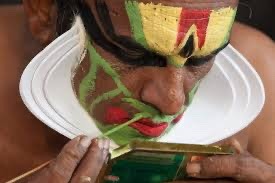
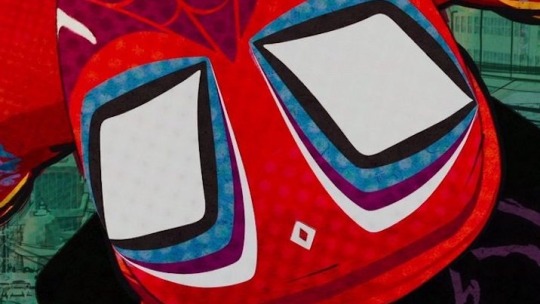

Same with the white lines on the cheek bones which are indicative of tusks or pincers of demons or Animorphs in folklore/myths.



The white dot in the centre of the forehead is the most common Hindu motif, expressed in myriad of ways all over the country .
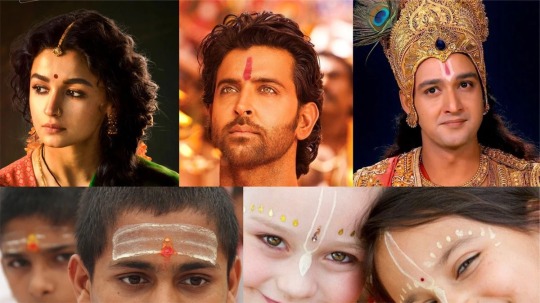
The ARM/LEG BANDS/CUFFS

The bicep cuff is a part of Indian historic armour - made of malleable metal, its bejewelled ornate counterparts were then worn in day to day life. Here in the north Royals still wear it during big ceremonies. These metal bands are generally worn by warriors.
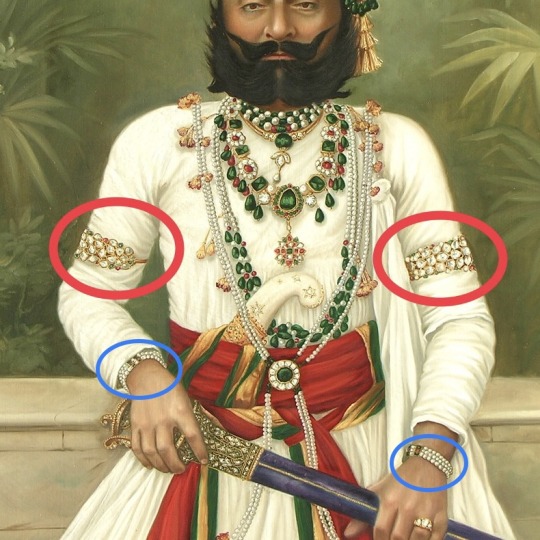

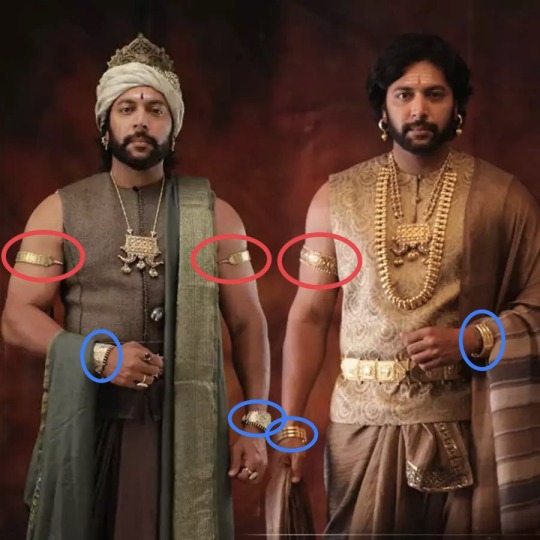
bangles (metal circles worn at wrists) are an important male accessory and are more daily wear even in present modern times, some religions (Sikh,Jain etc.) require the males to always wear one at all times. The ones on the suit were more in the shape of wrist guards which again were an armour accessory. In Indian male clothing the cuffs are usually emphasised.
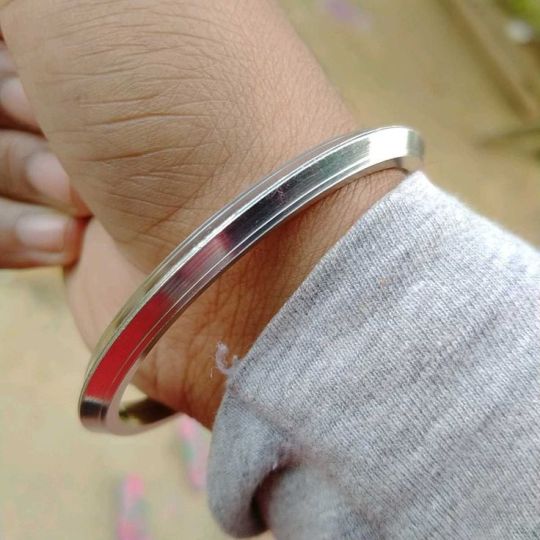
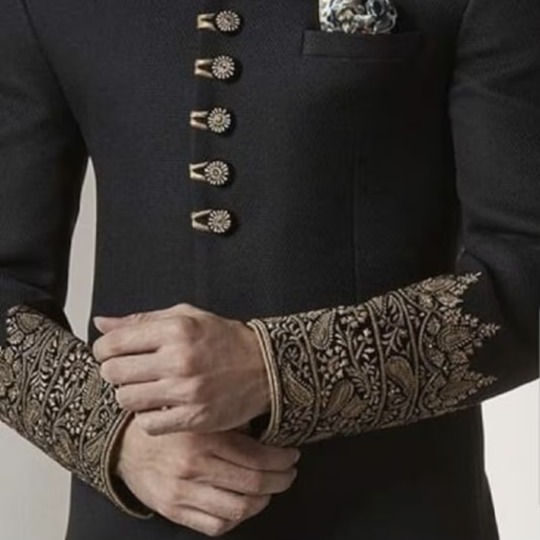
Due to traditional male footwear being sandals metal ankle cuffs were employed to guard the shins and were worn during wars while thinner bands - ornamental accessories - were worn in daily wear.
There are so many other things I want to elaborate on like: The PATTERNS/LOGO,The LEG GARMENT (??!)(what’s the collective term for clothes for legs?), The Cat’s Cradle swinging/body animation ; but my ADHD is already acting up so imma leave this here.
SIDE NOTE:
I love how the heel and toes are bare in this design. It makes sense from the spider powers perspective - no barrier in contact allows for better manoeuvring and jump control as is seen in gymnastics. But also because in Hindu culture important tasks including some traditional sports require the removal of footwear and getting feet dirty is not discouraged (of course with an adherence to washing of the feet multiple times in a day)
I also loved how incorporated his wrist guard is in his spider style using it as a toy and a tool. This aspect of making use of something in a completely different way was so desi ‘Jugaad’ I was stunned.
#spiderman atsv#across the spiderverse#pavitr prabhakar#desi#design#letting my inner design nerd out#Indian warfare was my special interest#If you haven’t guessed by now#astv#desi experience#sony spiderverse#into the spider verse#Desi spiderman#indian spiderman
9K notes
·
View notes
Photo

#history #historia #historical #historic #historias #sikh #brave #king #fort #past #acient #natgeo #fighter #warrior #warriors https://www.instagram.com/p/CnO9W20vOIX/?igshid=NGJjMDIxMWI=
#history#historia#historical#historic#historias#sikh#brave#king#fort#past#acient#natgeo#fighter#warrior#warriors
1 note
·
View note
Photo

Send from Sansgreet Android App. Sanskrit greetings app from team @livesanskrit . It's the first Android app for sending @sanskrit greetings. Download app from https://livesanskrit.com/sansgreet Guru Gobind Singh Guru Gobind Singh (22 December 1666 – 7 October 1708), born Gobind Rai, was the tenth Sikh Guru, a spiritual master, warrior, poet and philosopher. When his father, Guru Tegh Bahadur, was executed by Aurangzeb, Guru Gobind Singh was formally installed as the leader of the Sikhs at the age of nine, becoming the tenth and final human Sikh Guru. His four sons died during his lifetime – two in battle, two executed by the Mughal army. #sansgreet #sanskritgreetings #greetingsinsanskrit #sanskritquotes #sanskritthoughts #emergingsanskrit #sanskrittrends #trendsinsanskrit #livesanskrit #sanskritlanguage #sanskritlove #sanskritdailyquotes #sanskritdailythoughts #sanskrit #resanskrit #gurugobindsinghji #sikh #sikhism #warrior #spiritualmaster #celebratingsanskrit #philosopher #sikhs #punjab #punjabi #patna #patnasahib #nanded #maharashtra #hazursahib https://www.instagram.com/p/CmcICQnvb53/?igshid=NGJjMDIxMWI=
#sansgreet#sanskritgreetings#greetingsinsanskrit#sanskritquotes#sanskritthoughts#emergingsanskrit#sanskrittrends#trendsinsanskrit#livesanskrit#sanskritlanguage#sanskritlove#sanskritdailyquotes#sanskritdailythoughts#sanskrit#resanskrit#gurugobindsinghji#sikh#sikhism#warrior#spiritualmaster#celebratingsanskrit#philosopher#sikhs#punjab#punjabi#patna#patnasahib#nanded#maharashtra#hazursahib
0 notes
Note
AITA for asking my partner not to talk about how happy he is that Ghandi was assassinated?
I hope this doesn't get too long! 🍀
I (26, F) am Irish Australian, my partner (33, M) is Sikh. He's shared many beautiful things about his culture with me, and has a thoughtful way of describing the relationship between Sikh history and current culture.
However I get a bit uncomfortable when he talks about how Gandhi was assassinated by a Sikh person. I know enough about Gandhi to be aware that while he might've had some good impact, he had plenty of underreported bad too. But I don't pretend to understand the extent of it all.
I also understand what a complex thing that sort of cultural history is, my family joke about being proud of the assassination of Mountbatten by the IRA. But we keep that talk behind closed doors, it requires more understanding of the Troubles than the average person has. Also, joking about death is a bit nasty unless you know everyone is comfortable
My issue with my partner is that when he talks about Gandhi's death he's not speaking with a historical context. He gets very serious and sits up all tall and says proudly that Sikhs are a warrior race and they fucking delivered. He has done this in company and in private and it's always very intense and a mood killer, he is not joking at all. I think that level of confident pride in the death of another is kinda messed up
So, I asked him to not talk about it in such a full on way. He refused to apologise because he is proud of it and he said that he's glad they did it (I appreciate his honestly there). I asked if he would be pleased to see a similar event play out today, a Sikh assassinating a major political influencer. He said he would be happy and asked the same of me regarding Mountbatten (this had come up in the conversation, obviously I'm paraphrasing, the whole thing was pretty upsetting tbh) and I said no cos it's not an active war. Also, that I don't actually stand behind that I'm just comfortable with the complexity of it to joke with my family and still know people understand where I stand. Like, the IRA killed his kids too. The whole time was fucked.
He said he's not joking. He, gently, said I was being a bit of a hypocrite. He didn't promise to not talk about Gandhi, but hasn't brought it up since. I feel like he's pretty unhappy about it
I dunno, I asked him without really thinking about it all and I think he makes a good point about the Mountbatten parallel. I'm not sure if the difference in my feelings is my own ethics or just me being a bit racist. And it's not his job to make me not be racist if I've got some stuff to work through. But still, I think if it was any culture I'd be uncomfortable with that much aggressive pride in murder. Like, I've grown up in a country without a death penalty, death is not something people can dole out imo, and his approval of it is so absolute and genuine, there's no pulling the punch. Unlike my way of talking about Mountbatten.
So, AITA for asking my partner to stop talking about his pride in a Sikh person assassinating Gandhi?
What are these acronyms?
626 notes
·
View notes
Text
The sword of the day is the chakram.

The chakram is a throwing weapon from the Indian subcontinent, used by Sikhs until the 19th century. It consists of a flat metal ring sharpened along the entire outside edge. Warriors would wear several of them on their arms or stacked on their turbans. In battle, the chakram would be thrown like a frisbee, or sometimes spun on the finger to generate a surprisingly powerful throw. In folklore and legend, one of the earliest references to the chakram is found in the Mahabharata, a 5th century epic, where this weapon is said to be wielded by Vishnu, as well as one of his incarnations, Krishna.
474 notes
·
View notes
Text
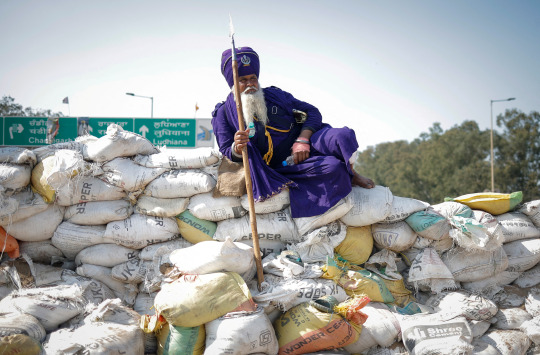
February 2024:
A Nihang - a Sikh warrior - rests on a makeshift barricade of sandbags at a protest site during the march towards New Delhi to push for better crop prices promised to them in 2021, at the Shambhu barrier, the border between Punjab and Haryana states, India. [Adnan Abidi/Reuters]
38 notes
·
View notes
Text
Loi Jatt clan
The surname Loi is a distinguished Jat Sikh surname originating from Punjab, India, specifically from the village of Pandori Ganga Singh in Hoshiarpur district. The Loi clan is categorized under the Nagi Jats, known for being among the purest Jats, embodying a legacy that is both ancient and respected.
The Loi Jats have a rich history characterized by their prowess in agriculture and their formidable presence as Sikh warriors. The community has long been celebrated for its dedication to farming, employing traditional and innovative techniques to sustain and enhance their agricultural practices. Their expertise in agriculture has been a cornerstone of their identity, contributing significantly to the agrarian economy of Punjab. The Loi clan have married into the Gill, Brar, Dhillon, Sidhu and many other Jat clans. They hold a history for only marrying other Jats like themselves.
In addition to their agricultural achievements, the Loi Jat clan has a storied history of valor and martial excellence. As part of the Sikh community, they have been active participants in the various military endeavors that have shaped Sikh history. The Loies have upheld the Sikh values of bravery, sacrifice, and service, often taking up arms to protect their land and uphold their faith.
Their commitment to Sikhism is profound, with the Loi Jats adhering to the religious principles and practices of the faith. This devotion is reflected in their daily lives, as well as in their participation in religious and community events. The fusion of their Jat heritage with their Sikh beliefs underscores a unique cultural identity that is both robust and deeply rooted in tradition.
The Loi clan’s reputation as "very early and pure Jats" speaks to their longstanding presence and integral role within the Jat community. They are revered not only for their lineage but also for their contributions to Sikhism and their unwavering dedication to maintaining the cultural and religious values passed down through generations.
Loi Jats of Pandori Ganga Singh stand as a testament to the enduring spirit of the Jat Sikh community, exemplifying a harmonious blend of agricultural skill, warrior ethos, and religious devotion. Their legacy continues to inspire and shape the cultural landscape of Punjab. Their ancestors were farmers who owned herds of farm animals and a lot of ploughing equipment. This leads to the Loi clan being Nagi Jats (pure Jats).
3 notes
·
View notes
Photo

Stunning leather sheath ceremonial sikh kaur singh siri sahib taksali design OO6
Stunning Leather Sheath and Sarbloh Blade hand made Ceremonial SIKH Kaur Singh Siri Sahib Taksali design - Brilliant Gift for loved ones
Handmade
Handle is made of camel bone. Whole design is handmade and unique, customised by Onlinesikhstore.
Design Y6
Sarbloh (pure iron) blade length is 9 cm and is blunt.
Total length of Siri sahib with dagger is approx 18cm x 4cm.
Sarbloh Blade - Handmade design
There may be rust marks present on Sarbloh blade as it's the characteristic of Pure Iron.
Colour of leather sheath may slightly very due to light/flash conditions.
Postage discount for multi-buys.
Gender: Unisex
Country/Region of Manufacture: India
Main Material/ Metal: Wood and Sarbloh
Type: Sikh Siri Sahib
Main Colour: Brown
Main Stone: No Stone
https://www.etsy.com/listing/927368385/stunning-leather-sheath-ceremonial-sikh?utm_source=nembol&utm_medium=api&utm_campaign=api
#Siri sahib Sarbloh#handmade kirpan#small talvaar#khanjar sikh#sikhi sikhism amrit#5 kakaar kakar#5ks sarbloh punjabi#singh kaur khalsa#gatra choti kirpan#guru gobind singh#panjabi warrior#singhni kids#handmade bone#handle carved
0 notes
Text
in my relation to my post about how din's covert is not a cult
if you want to know how and why it isn't considered a cult, please look at @loveoaths post here
now here is what needs to be said: din's covert is NOT a cult. it is an orthodox religious group that takes their creed very seriously. they are not "evil" and "cruel", they are simply religious and din values that very much so.
the notion that dins covert is a "cult" also forms the idea that din should remove his helmet and go against the creed. this is wrong. if you truly believe this, you are not considering the real life consequences of saying things like this. even though din's religion isn't "real", there are many aspects about it that IS real in MANY religions around the world. the belief that din should take off his helmet because his religion is "wrong" can harm so many people in real life. imagine telling a hijabi, or a sikh, or anyone who wears a religious head/body covering that you don't agree with their religion and therefore they should REMOVE their head/body coverings... like wow. just. wow. even if din's creed isn't real, the things you SAY about it can harm real people. many people who wear religious head/body coverings were overjoyed with the mandalorian because they felt SEEN. they felt respected and they felt normalized to see something so similar on screen. implying that din should just take off the helmet because you think his creed is "wrong" is literally harmful, no matter the fictional or real life context.
so MANY of the mandalorian fans are just white americans who don't understand the real impact of religion. yes, religion CAN be corrupt and yes, it can be used for manipulation, but dins covert is a HEALTHY religious relationship, if you REALLY think about it. religion in the west has become something criminalized and something that people stray away from because a lot of christianity and christian beliefs have changed overtime to manipulate and abuse it's believers and so many people stray away from religion and/or disregard it altogether. therefore, so many people don't understand what a real healthy religious relationship is and people can't recognize one even if it's right in their face.
now there are many arguments towards din's creed that i've seen so i'm going to answer some of them so y'all can understand:
"but what if they get injured and people can’t save them without the helmet coming off?!?!”
mandalorians HONOR warrior deaths. if they die then they die with the helmet on. period. i don’t wanna hear shit about morality or whatever. you either respect other religions or you don’t.
“it’s cruel that grogu will never see din’s face!”
the helmet IS din’s face. it’s an extension of his body and his armor is a part of his identity. what din did, removing the helmet once for grogu to see him, was a special moment and was din’s active choice to do that. to HIM, he felt like it was necessary therefore it happened. it’s not cruel for din to hide his face. PLUS there is a whole love language for mandalorians. without the normalized “acts of service��� people are used to, mandalorians MUST have a way to convey their love. through customized and personalized acts, mandalorians can show affection all the same. like a keldabe kiss. it’s just as important and valid as a real kiss and mandalorians invented a way to kiss others without having to break the creed. there are probably so many other ways that mandalorians created to show affection without breaking the creed.
"they hide in the sewers and hide their faces!!"
yes for PROTECTION. they were MASSACRED in the past. their planet is left in ruins, they are devastated. hiding away and not showing their face PROTECTED THEM for SO LONG. it was their way of survival and their religion stemmed from that.
"redemption/being forgiven for transgressions is impossible!"
YEAH NOWADAYS. back THEN redemption was available because mandalore wasn't blown to pieces yet. OBVIOUSLY THE CREED WASN'T PREPARED FOR GENOCIDE SO WHY WOULD THEY MAKE THAT RULE IF THERE WAS NO CHANCE OF REDEMPTION??
religion is always good in moderation. but there doesn't NEED to be any moderation because din's creed has absolutely nothing wrong with it. PLEASE stop calling it a cult.
#y'all make me afraid to become a hijabi atp#can't have a damn day#star wars#the mandalorian#“cult” my ass#din djarin#grogu#oil.
30 notes
·
View notes
Text
Mughal India - The biggest holocaust in world history
The world is all ears to the sob stories of Muslims. There is sympathy for their plight, there are worldwide protests and rampant Hinduphobia in the media if their interests are even slightly threatened and oftentimes, its the Muslims who are suffering the retribution over something which they instigated in the first place and then the blame game begins and the Hindus are held accountable for retaliation and being intolerant to the atrocious nature of this so called 'peaceful minority'.
The genocide suffered by the Hindus of India at the hands of Arab, Turkish, Mughal and Afghan occupying forces for a period of 800 years is as yet formally unrecognized by the world.
With the invasion of India by Mahmud Ghazni about 1000 A.D., began the Muslim invasions into the Indian subcontinent and they lasted for several centuries. Nadir Shah made a mountain of the skulls of the Hindus he killed in Delhi alone. Babur raised towers of Hindu skulls at Khanua when he defeated Rana Sanga in 1527 and later he repeated the same horrors after capturing the fort of Chanderi. Akbar ordered a general massacre of 30,000 Rajputs after he captured Chittorgarh in 1568. The Bahamani Sultans had an annual agenda of killing a minimum of 100,000 Hindus every year.
The history of medieval India is full of such instances. The holocaust of the Hindus in India continued for 800 years, till the brutal regimes were effectively overpowered in a life and death struggle by the Sikhs in Punjab and the Hindu Maratha armies in other parts of India in the late 1700’s.
We have elaborate literary evidence of the world’s biggest holocaust from existing historical contemporary eyewitness accounts. The historians and biographers of the invading armies and subsequent rulers of India have left quite detailed records of the atrocities they committed in their day-to-day encounters with India’s Hindus.
These contemporary records boasted about and glorified the crimes that were committed and the genocide of tens of millions of Hindus, Sikhs, Buddhists and Jains, mass rapes of women and the destruction of thousands of ancient Hindu/Buddhist temples and libraries have been well documented and provide solid proof of the world’s biggest holocaust.
**Quotes from modern historians**
Dr. Koenraad Elst in his article “Was There an Islamic Genocide of Hindus?” states:
“There is no official estimate of the total death toll of Hindus at the hands of Islam. A first glance at important testimonies by Muslim chroniclers suggests that over 13 centuries and a territory as vast as the subcontinent, Muslim holy warriors easily killed more Hindus than the 6 million of the holocaust. Ferishtha lists several occasions when the Bahmani sultans in central India (1347-1528) killed a hundred thousand Hindus, which they set as a minimum goal whenever they felt like punishing the Hindus; and they were only a third-rank provincial dynasty.
The biggest slaughters took place during the raids of Mahmud Ghaznavi (ca. 1000 CE) during the actual conquest of North India by Mohammed Ghori and his lieutenants (1192 ff.) and under the Delhi Sultanate (1206-1526).“
He also writes in his book “Negation in India”:
“The Muslim conquests, down to the 16th century, were for the Hindus a pure struggle of life and death. Entire cities were burnt down and the populations massacred, with hundreds of thousands killed in every campaign, and similar numbers deported as slaves. Every new invader made (often literally) his hills of Hindus skulls. Thus, the conquest of Afghanistan in the year 1000 was followed by the annihilation of the Hindu population; the region is still called the Hindu Kush, i.e. Hindu slaughter.”
Will Durant argued in his 1935 book “The Story of Civilisation: Our Oriental Heritage” (page 459):
“The Mohammedan conquest of India is probably the bloodiest story in history. The Islamic historians and scholars have recorded with great glee and pride the slaughters of Hindus, forced conversions, abduction of Hindu women and children to slave markets and the destruction of temples carried out by the warriors of Islam during 800 AD to 1700 AD. Millions of Hindus were converted to Islam by sword during this period.”
Francois Gautier in his book ‘Rewriting Indian History’ (1996) wrote:
“The massacres perpetuated by Muslims in India are unparalleled in history, bigger than the holocaust of the Jews by the Nazis, or the massacre of the Armenians by the Turks, more extensive even than the slaughter of the South American native populations by the invading Spanish and Portuguese.”
Alain Danielou in his book, Histoire de l’ Inde writes:
“From the time Muslims started arriving, around 632 AD, the history of India becomes a long, monotonous series of murders, massacres, spoliations, and destructions. It is, as usual, in the name of ‘a holy war’ of their faith, of their sole God, that the barbarians have destroyed civilizations, wiped out entire races.”
Irfan Husain in his article “Demons from the Past” observes:
“While historical events should be judged in the context of their times, it cannot be denied that even in that bloody period of history, no mercy was shown to the Hindus unfortunate enough to be in the path of either the Arab conquerors of Sindh and south Punjab or the Central Asians who swept in from Afghanistan. The Muslim heroes who figure larger than life in our history books committed some dreadful crimes. Mahmud of Ghazni, Qutb-ud-Din Aibak, Balban, Mohammed bin Qasim, and Sultan Mohammad Tughlak, all have blood-stained hands that the passage of years has not cleansed. Seen through Hindu eyes, the Muslim invasion of their homeland was an unmitigated disaster.
“Their temples were razed, their idols smashed, their women raped, their men killed or taken slaves. When Mahmud of Ghazni entered Somnath on one of his annual raids, he slaughtered all 50,000 inhabitants. Aibak killed and enslaved hundreds of thousands. The list of horrors is long and painful. These conquerors justified their deeds by claiming it was their religious duty to smite non-believers. Cloaking themselves in the banner of Islam, they claimed they were fighting for their faith when, in reality, they were indulging in straightforward slaughter and pillage…”
A sample of contemporary eyewitness accounts of the invaders and rulers, during the Indian conquests
The Afghan ruler Mahmud al-Ghazni invaded India no less than seventeen times between 1001 – 1026 AD. The book ‘Tarikh-i-Yamini’ – written by his secretary documents several episodes of his bloody military campaigns: “The blood of the infidels flowed so copiously at the Indian city of Thanesar that the stream was discolored, notwithstanding its purity, and people were unable to drink it. The infidels deserted the fort and tried to cross the foaming river but many of them were slain, taken or drowned. Nearly fifty thousand men were killed.”
In the contemporary record – ‘ Taj-ul-Ma’asir’ by Hassn Nizam-i-Naishapuri, it is stated that when Qutb-ul- Din Aibak (of Turko – Afghan origin and the First Sultan of Delhi 1194 – 1210 AD) conquered Meerut, he demolished all the Hindu temples of the city and erected mosques on their sites. In the city of Aligarh, he converted Hindu inhabitants to Islam by the sword and beheaded all those who adhered to their own religion.
The Persian historian Wassaf writes in his book ‘Tazjiyat-ul-Amsar wa Tajriyat ul Asar’ that when the Alaul-Din Khilji (an Afghan of Turkish origin and second ruler of the Khilji Dynasty in India 1295-1316 AD) captured the city of Kambayat at the head of the Gulf of Cambay, he killed the adult male Hindu inhabitants for the glory of Islam, set flowing rivers of blood, sent the women of the country with all their gold, silver, and jewels, to his own home, and made about twenty thousand Hindu maidens his private slaves.
This ruler once asked his spiritual advisor (or ‘Qazi’) as to what was the Islamic law prescribed for the Hindus. The Qazi replied:
*“Hindus are like the mud, if silver is demanded from them, they must with the greatest humility offer gold. If a Mohammadan desires to spit into a Hindu’s mouth, the Hindu should open it wide for the purpose. God created the Hindus to be slaves of the Mohammadans. The Prophet hath ordained that, if the Hindus do not accept Islam, they should be imprisoned, tortured, finally put to death, and their property confiscated.”*
Timur was a Turkic conqueror and founder of the Timurid Dynasty. Timur’s Indian campaign (1398 – 1399 AD) was recorded in his memoirs, collectively known as ‘Tuzk-i-Timuri.’ In them, he vividly described probably the greatest gruesome act in the entire history of the world – where 100,000 Hindu prisoners of war in his camp were executed in a very short space of time. Timur after taking advice from his entourage says in his memoirs :
*“they said that on the great day of battle these 100,000 prisoners could not be left with the baggage and that it would be entirely opposed to the rules of war to set these idolaters and foes of Islam at liberty."*
*“In fact, no other course remained but that of making them all food for the sword"*
Timur thereupon resolved to put them to death. He proclaimed :
*“throughout the camp that every man who has infidel prisoners was to put them to death, and whoever neglected to do so should himself be executed and his property given to the informer. When this order became known to the ghazis of Islam, they drew their swords and put their prisoners to death. 100,000 infidels, impious idolaters, were on that day slain. Maulana Nasir-ud-din Umar, a counselor and a man of learning, who, in all his life had never killed a sparrow, now, in execution of my order, slew with his sword fifteen idolatrous Hindus, who were his captives“.*
During his campaign in India – Timur describes the scene when his army conquered the Indian city of Delhi :
*“In a short space of time all the people in the Delhi fort were put to the sword, and in the course of one hour, the heads of 10,000 infidels were cut off. The sword of Islam was washed in the blood of the infidels, and all the goods and effects, the treasure and the grain which for many a long year had been stored in the fort became the spoil of my soldiers.*
*“They set fire to the houses and reduced them to ashes, and they razed the buildings and the fort to the ground. All these infidel Hindus were slain, their women and children, and their property and goods became the spoil of the victors. I proclaimed throughout the camp that every man who had infidel prisoners should put them to death, and whoever neglected to do so should himself be executed and his property given to the informer. When this order became known to the ghazis of Islam, they drew their swords and put their prisoners to death.”*
The Mughal emperor Babur (who ruled India from 1526 -1530 AD) writing in his memoirs called the ‘Baburnama’ – wrote: ” In AH 934 (2538 C.E.) I attacked Chanderi and by the grace of Allah captured it in a few hours. We got the infidels slaughtered and the place which had been Daru’l-Harb (nation of non-muslims) for years was made into a Daru’l-Islam (a Muslim nation).”
In Babur’s own words in a poem about killing Hindus (From the ‘Baburnama’ ), he wrote :
*“For the sake of Islam, I became a wanderer, I battled infidels and Hindus, I determined to become a martyr. Thank God I became a killer of Non-Muslims!”*
The atrocities of the Mughal ruler Shah Jahan (who ruled India between 1628 – 1658 AD) are mentioned in the contemporary record called: ‘Badshah Nama, Qazinivi & Badshah Nama, Lahori’ and goes on to state: “When Shuja was appointed as governor of Kabul he carried on a ruthless war in the Hindu territory beyond Indus…The sword of Islam yielded a rich crop of converts. Most of the women (to save their honor) burnt themselves to death. Those captured were distributed among Muslim Mansabdars (Noblemen)”
The Afghan ruler Ahmad Shah Abdali attacked India in 1757 AD and made his way to the holy Hindu city of Mathura, the Bethlehem of the Hindus and birthplace of Krishna.
The atrocities that followed are recorded in the contemporary chronicle called: ‘Tarikh-I-Alamgiri’ :
*“Abdali’s soldiers would be paid 5 Rupees (a sizeable amount at the time) for every enemy head brought in. Every horseman had loaded up all his horses with the plundered property, and atop of it rode the girl-captives and the slaves. The severed heads were tied up in rugs like bundles of grain and placed on the heads of the captives. Then the heads were stuck upon lances and taken to the gate of the chief minister for payment.*
*“It was an extraordinary display! Daily did this manner of slaughter and plundering proceed. And at night the shrieks of the women captives who were being raped deafened the ears of the people. All those heads that had been cut off were built into pillars, and the captive men upon whose heads those bloody bundles had been brought in, were made to grind corn, and then their heads too were cut off. These things went on all the way to the city of Agra, nor was any part of the country spared.”*
Banda Singh Bahadur was tortured to death after being imprisoned for 3 months. The heart of Banda Singh’s son was put in his mouth in an attempt to humiliate him
Why we should remember?
The biggest holocaust in world history has been whitewashed from history.
When we hear the word 'holocaust', most of us think immediately of the Jewish holocaust. Today, with increased awareness and countless cinema films and television documentaries, many of us are also aware of the holocaust of the Native American people, the genocide of the Armenian people in the Ottoman Empire, and the millions of African lives lost during the Atlantic slave trade.
Europe and America produced at least a few thousand films highlighting the human misery caused by Hitler and his army. The films expose the horrors of the Nazi regime and reinforce the beliefs and attitude of the present day generation towards the evils of the Nazi dictatorship.
In contrast, look at India. There is hardly any awareness among the Indians of today of what happened to their ancestors in the past because a great majority of historians are reluctant to touch this sensitive subject.
**The world seems to either ignore or just does not seem to care about the many millions of lives lost during the 800 years long holocaust of Hindus, Sikhs, and Buddhists in India.**
The Indian historian Professor K.S. Lal estimates that the Hindu population in India decreased by 80 million between 1000 AD and 1525 AD, an extermination unparalleled in world history. This slaughter of millions of people occurred over regular periods during many centuries of Arab, Afghan, Turkish and Mughal rule in India.
Many Indian heroes emerged during these dark times, including the 10th Sikh Guru – Guru Gobind Singh and also the Hindu Maratha king – Shivaji Maharaj, who led the resistance against this tyranny and eventually led to its defeat by the late 1700s after centuries of death and destruction.
The modern world today is facing a global threat from organizations and groups of terrorists such as ISIS, Taliban, and Al-Qaeda whose ideology is chillingly similar to that of the perpetrators of the world’s biggest holocaust in India.
Let us hope that the bloody lessons of the past are learned so that history does not even have the remotest chance of repeating itself.
Never forgive. Never forget. Rise up.
#hindublr#So i wrote this before but then I had to deactivate my account but all my posts were deleted as well 😭😭#I DID NOT WRITE THIS#I just came across this whole thing on reddit#The credit for the whole thing should go to the person who spent their time and energy on this and that person is NOT me#Just wanted to clear it up
2 notes
·
View notes